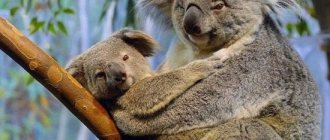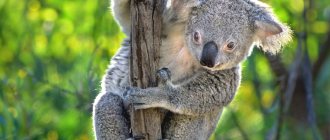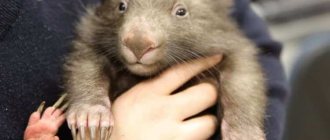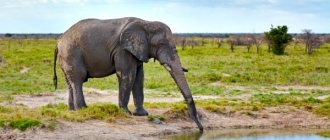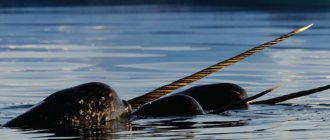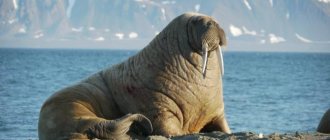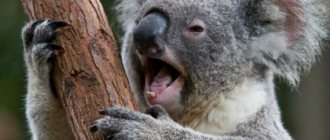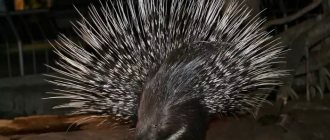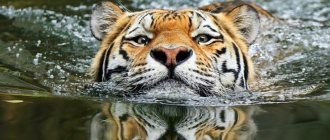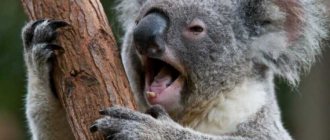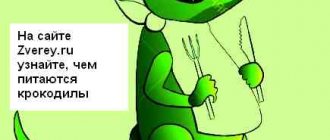Marsupial koalas simultaneously resemble a stuffed toy or a small bear. And although outside Australia they are called “tree bears,” they have nothing to do with real predators.
Funny and unusual animals belong to the order of two-incisor marsupials, the genus of koalas.
Their population inhabits the eastern part of the Australian mainland. Unfortunately, today the population that lived in the western part of the continent has been completely exterminated.
Koalas are not bears
0
In appearance, the koala really resembles a bear, but the animal is neither a panda nor a bear. The koala is a representative of a large group of marsupials; their young are born prematurely and are subsequently borne in a pouch - a fold of skin or on the mother's stomach. Other marsupials are considered close relatives of koalas; by the way, there are not many of them left on our planet - about 250 species, mostly all of them live in Australia. The koala itself is an animal that does not belong to any species.
Kinds
The lifespan of koalas on Earth, as a family of ancient marsupial bears, according to scientists, is estimated at 30 million years. But in those distant times that have sunk into oblivion, its representatives looked somewhat different.
And many of them could boast sizes that exceeded the size of modern animals from this family by a couple of dozen times. All this is proven by the fossil remains of these creatures. There were especially many such finds in the southern regions of Australia.
Also, a lot of this kind of fossils were found in Queensland, one of the states of the continent. Koalas still live in this area of the planet: they weigh no more than 9 kg and are gray in color. But in the state of Victoria, modern animals of this type are found larger. And they have predominantly chocolate-colored fur.
It should be noted that, regardless of the size of these animals living in a particular area, males differ significantly in size from females, more specifically, they are almost twice as long in body length and in weight.
The koala in the form in which it now exists on the planet appeared only 15 million years ago. She is considered a relative of the wombat. This is also a very ancient Australian inhabitant, an animal similar to the koala in many ways. In its modern form it also resembles a small bear, although it is still somewhat larger than the described animal.
Today, the koala is considered the only representative of the koala family and is classified as a species of the same name, which is also called a marsupial bear. Although purely biologically and genetically, such animals are not related to bears at all. The koala in the photo perfectly demonstrates all the funny and very cute external features of these animals.
Found only in Australia
0
Such cute and beautiful animals as koalas live in Australia, mainly in its western part, in eucalyptus forests. They prefer to climb trees, and do it very skillfully. For the marsupial, a humid climate and palm trees (or eucalyptus trees) are important, on which the koala can sit for a long time and chew leaves. The forest provides food for the herbivore. Speaking of nutrition, the koala is very selective in this matter, and will not eat just anything, but prefers only eucalyptus.
Lifestyle and habitat
These are inhabitants of eucalyptus forests. Among the thickets of such trees, moving along their trunks, branches and crowns, such creatures spend all the days of their existence, from the first to the last. Koalas are also quite capable of moving on the ground, although not very well. They go down only if there is a desire to move to another tree in a similar way.
During the day, these animals usually rest, so at this time of day you can only see a sleeping koala . But even during waking hours they are not particularly active. These creatures are very lazy; it is believed that they spend up to twenty hours a day in a motionless state.
The only thing they can do deftly, quickly and skillfully is climb trees, masterfully jumping from one branch to another. On the tops of eucalyptus trees they usually escape from ill-wishers. These animals are also capable of swimming well.
Koalas do not have a great desire to communicate with their own kind. The only exceptions are during breeding periods, when they are forced, by the call of nature, to look for a partner. However, at other times there are some differences in the behavior of the different sexes.
Females prefer to settle only in a certain territory, usually without leaving the areas they have previously chosen. There they exist peacefully, not reacting much to what is happening around them, busy only with long sleep and caring about filling their stomach.
Males are not particularly attached to their territories. And sometimes a craving for short-distance travel awakens in them. And when they meet each other, they not only do not experience much joy, but are also capable of starting a fight. Such showdowns are even more relevant during the mating season. And at such a time, for bullies, these fights can become more than harmless.
But such creatures do not pose a danger to people, so they are kept without special precautions in some zoos. After all, for visitors, a koala is small bear There is almost no need to guard such inhabitants in cages due to the lack of a natural desire for active movement.
There is a known case when one marsupial bear named Mundu tried to escape from the San Diego Zoo, but was not particularly successful in his quest for freedom. The fact is that the koala, rushing into an unknown world, fell asleep on the way. Thus, the adventurer did not cause excessive trouble to the zoo workers.
True, keeping such animals in captivity still has its unpleasant sides, and sometimes it can actually be difficult due to the peculiarities of their diet, which will be discussed further.
Relatives of wombats
0
These animals are relatives of koalas. Because of their fur and cute faces, wombats look like soft toys and at the same time like pigs. Wombats spend most of their lives in burrows, resting in them during the day; they prefer to be nocturnal. By the way, their underground dwelling cannot be called just burrows - wombats build entire settlements, which include tunnels and streets. Wombats deftly move through constructed labyrinths along with their families. Wombats, like koalas, live in Australia and can also be found in Tasmania. Today there are only 2 types of wombats left: long-haired and short-haired.
What is useful and what is harmful
The koala animal is cute and kind, but it can harm and help a person as well.
Zoos love koalas. You can see many photos of koalas and people together. But breeders often conduct experiments on these animals.
Koalas are not harmed on purpose, but only due to lack of food. They can get out onto the road, which leads to accidents in transport, the color of the koala is gray, so they can sometimes be missed.
The koala is an unusual animal that has not been fully studied.
There are fingerprints
0
We all know about human-monkey matches, human-pig matches, etc., but perhaps you haven't heard of human-koala matches before. Now you find out that an Australian resident and a person have similar fingerprints. Each animal has its own unique pattern on the “sole of the hand.” These cute marsupials are somewhat similar to humans - of course, they lag behind in terms of intelligence, and we have different food preferences. However, fingerprints are what unites us. If you look at them under a microscope, you will not find any differences... Moreover, in 1996, thanks to this discovery, scientists suggested that vortices and lines increase the tenacity of the limbs.
What do koalas eat?
Eucalyptus has evergreen leaves, so koalas feed on them all year round. In one day, an adult koala can eat up to 500 grams of food. The animals do not feed on all types of eucalyptus, but only 30 out of 600.
For many herbivores, eucalyptus is poisonous and harmful. The koala is an animal with adaptations that allow eucalyptus leaves to be digested and absorbed into the body. This food is low in calories, so the animals sleep almost all the time.
Motionless most of the day
0
For most of the day, Australian koalas are motionless. During the day they sleep for approximately 16 hours, and even if they do not, they prefer to sit still and look around. The main thing is that when they are sleeping, no one shakes the tree or the wind blows; if this happens, the koala will fall from the tree, and the consequences can be sad. By sitting still, the animal conserves its energy in this way - this allows it to digest food, given that this takes a lot of time.
Lifestyle and character traits
Koalas are active mainly in the evening and at night, and during the day they prefer to sleep on tree branches. Animals lead a solitary lifestyle and form pairs only during the mating season. In general, these are good-natured and phlegmatic animals that actually eat and sleep.
Koalas rarely come to the ground.
The reasons for movement can only be the search for food, danger or a watering hole. By the way, they go to drink water in exceptional cases, when the weather is dry or when the animal is thirsty during illness.
Lifestyle of koalas
Female koalas prefer a sedentary lifestyle and usually do not leave their territory. In contrast, males move frequently and do not have clear territory boundaries. Females react neutrally to uninvited guests, but may drive them away if they plan to settle for a long time. Males jealously monitor the penetration of rivals, especially during the mating season, and expel them from their area.
Males mark their territory with scent glands located on their abdomen.
They rub against branches and tree trunks, and if they descend to the ground, they try to mark every pebble and hillock.
Sound sleep is the main activity of the koala.
They sit on tree branches, tightly grasping them with their paws. Usually animals fall asleep while sitting, hugging a branch, but they can funny fall back on their backs in the heat.
Character and habits
In everyday life, koalas are slow, but in case of danger they can quickly jump off a branch and run away, leaning on all their limbs (on all fours). Koalas rarely make sounds, but in case of a real threat they can scream loudly. The speed of a running animal does not exceed 10 km/h, but koalas are very agile and save themselves on tree branches. In the dense crown it is almost impossible to see a motionless animal.
Koalas are not cowardly and only run away from a real threat. If the enemy does not cause fear, they boldly attack him with their paws, emitting warlike grunts.
When kept in zoos, animals are not kept in groups, but kept separately from each other. Individuals occupy trees and jealously watch for trespassers. Koalas are friendly towards people. Currently, there are many nurseries in Australia that are trying to preserve the population. Visitors can pet the koalas or hold them. Animals love affection and attention.
Sedentary animals prefer not to waste energy in vain and try to reduce movements to a minimum.
When koalas wake up, they begin to eat without leaving their place and, if there is enough food, they fall asleep near the same branch.
If something interesting happens or animals see a new and unusual object, they freeze and can sit or stand in one position for hours.
When frightened, they make a sound similar to a child's cry.
0
It is better not to scare the koala again, because this amazing and cute animal makes a sound reminiscent of the cry of a small child... It cannot leave anyone indifferent. A wounded or frightened koala cries, but usually this animal does not make any sounds and prefers to remain silent most of the time. At the age of one year, a koala can begin to lead an independent life, but if its mother leaves it before that, the animal will cry because it is very attached to her.
Social structure and reproduction
Photo: Australian koala
Both females and males become sexually mature by the age of two. Females begin to reproduce at the same age, and males only a couple of years later, when they become more mature and stronger for skirmishes with other males in a dispute for a female. There are many more females born in the population, so each male has not one, but several brides at once. Koalas are not particularly fertile, so they produce offspring once every two years.
During the mating season, gentlemen emit heart-rending screams that attract females. They also rub their chests against tree trunks, placing their marks. During this period, grooms can travel considerable distances in search of partners, who can number from two to five. Females love larger and louder gentlemen, and their choice is based on these qualities. Like other marsupials, the koala's genitals have interesting features: the male has a bifurcated reproductive organ, and the female has two vaginas. The mating season lasts from September or October to February.
A koala's pregnancy lasts from 30 to 35 days. It very rarely happens that two babies are born at once; usually a single baby is born. It is completely naked, its skin is pinkish in color, the cub is very tiny - up to 1.8 cm long and weighs only 5 grams.
For the first six months of his life, the baby does not leave his mother’s bag, where he drinks milk with pleasure. For the next six months of its life, the slightly grown baby rides on its mother, holding onto her fur in the back or belly with his tenacious paws. By the age of thirty weeks, the baby switches from a milk diet to feeding on maternal excrement, consisting of half-digested eucalyptus leaves. He eats like this for a whole month.
Koalas become independent at one year of age. Females usually leave their mother at this time, beginning their adult life. And males live with their mother until they are two or three years old, only then they decide to leave her, acquiring their own territories for life.
Pregnancy lasts one month
0
A koala's pregnancy lasts no more than 30-35 days. Only one cub is born - at birth it has a body weight of 5.5 g and a length of only 15-18 mm. Females are born more often than males. It happens that twins appear, but this is rare. The cub remains in the mother’s pouch for six months, feeding on milk, and when this time passes, it “travels” for another six months on her back or stomach, clinging to her fur with its claws.
general characteristics
For several decades, it was believed that koalas are the closest relatives of kangaroos and wombats, but more detailed studies have proven that they have nothing to do with each other. Therefore, although koalas have some similarities with other animals, they are a separate, independent species.
The body length of a mature individual is from 60 to 85 cm, weight can vary between 4–15 kg.
The size of individuals directly depends on the place of residence. For example, animals living in the southern part of the continent can grow up to 85 cm with a weight of 15 kg. Their northern relatives are much smaller and rarely exceed 5–8 kg, with a body length of 60 to 70 cm.
The appearance of koalas is quite funny. The small head with large and hairy ears brings a lot of smiles. The ears are erect, but located on the sides of the head, which gives the animal an original appearance. The limbs are quite long with tenacious fingers and well-developed claws. The belly is protruding, the tail is small and hidden by fur.
Despite the overall size of their heads, animals have rather small brains. According to biologists? this is due to the monotonous and not very nutritious food.
On the forelimbs there are two two phalangeal fingers and three three phalangeal fingers. The hind feet have one big toe without claws and four regular toes with small claws. Incredibly strong and tenacious paws allow animals to move calmly through the trees. Well-developed toes on the front paws help koalas hold on to branches and collect food.
Surprisingly, the pads on koala fingers have unique prints like human fingers. Some scientists use this feature to identify animals.
Recommended by topic
Fox Panda Lynx
When an animal holds branches with its front paws, it places two toes on one side and three on the other. The toes on the hind limbs grasp objects in the same way, the thumb on one side and the four on the other. This grip is very strong, so it is quite difficult to “tear” the animal from the tree.
The eyes of koalas are located far from each other, small in size, the iris is black, dark brown or hazel. Koalas have rather poor eyesight, which is compensated by good hearing and smell. The nose is wide, flattened, black or dark brown.
Koalas have powerful jaws that help animals chew food. Number of teeth: 30 pieces. The front teeth are incisors for cutting plant food, the back teeth (molars) are for grinding food.
The entire body of animals is covered with thick, soft fur. The fur is not long, up to 3 cm, but there are a lot of them, so koalas look like plush toys. The hair on the ears and under the chin is much longer than on the body. The main color can be gray or brown. The chest, mask on the face and belly are snow-white.
Elena
Ask a Question
Question to the expert
How to distinguish a female from a male?
Externally, female and male koalas are very similar, but males are larger than females. Males have smaller ears than females. The external genitalia are hidden by dense fur, but females have a pouch on their abdomen for raising offspring, and males have a scent gland.
Life expectancy in the wild is from 13 to 18 years. In zoos, animals sometimes live up to 20 years.
In Australia, vines are stretched for them
0
Conservationists in Australia are working to save koalas. In order to prevent these beautiful animals from dying under the wheels, the Nature Conservancy came up with an interesting idea. For traffic safety, in some places artificial vines made of ropes were stretched over the roads - in this way, animals move from one tree to another and do not interfere with the movement of local residents. Traffic stops on the highway due to moving koalas are not uncommon in Australia.
Conservation in nature
Koalas have almost no enemies. Firstly, predators do not hunt them because their meat smells like eucalyptus. Secondly, in Australia there are no arboreal predators, and koalas live in trees almost around the clock
The number of koalas in nature can be up to one million. No one did any calculations. The main problem with the disappearance of koalas is deforestation; up to 400 thousand hectares of forest are destroyed every year.
They feed on poisonous leaves
0
You already know that koalas spend a lot of time sleeping, the rest is spent on food, namely on eating shoots and leaves of poisonous eucalyptus. In addition, the leaves are also very hard. Bacteria help koalas digest them. After receiving mother's milk, koalas do not yet have the necessary bacteria in their bodies, so at first the babies feed on their mother's droppings. Thus, they receive semi-digested eucalyptus leaves and microbiota - it does not take root in the intestines immediately, but gradually.
What do koalas eat?
The koala's main diet consists of leaves and young shoots of eucalyptus. But even koalas choose low-toxic varieties. There are more than 600 species of eucalyptus trees in the wild, but animals prefer to feed on only 50 species.
Thanks to their well-developed sense of smell, koalas accurately identify the right tree species.
Koalas do not eat other food, since their stomach is unable to digest and assimilate anything other than eucalyptus. In addition, a slow metabolism will not cope with the nutritional value of other food.
In their natural environment, koalas have virtually no food competitors.
The leaves and shoots have low nutritional value and high toxicity, so they are eaten only by a few species of animals.
One adult requires from 500 g to 1 kg of leaves and shoots per day. The daily diet completely meets the koala's need for nutrients, since they lead a sedentary lifestyle. Animals spend no more than 8 hours a day searching for food; the rest of the time they sleep and digest food. Koalas carefully chew each leaf into a mush to get the maximum benefit from each serving.
Koalas replenish their lack of nutrients and minerals by eating soil. If animals lack vitamins, they descend from the trees and lick the top layer of soil.
Koalas are often called “non-drinking” animals. This is partly a true statement, since unusual animals really make do with morning dew and leaf sap. But koalas, like other animals, can drink during dry periods or during illness. For drinking, they choose clean, running water. In this case, the amount of liquid per individual is no more than 300 ml.
Sometimes koalas do not swallow chewed leaves, but hold them in their cheeks.
This supply allows the animals to have a “snack” while resting. The animals wake up, take out the pulp with their tongue, swallow it and go back to sleep.
During drought or closer to autumn, koalas move to rivers and lakes, as the content of toxins in eucalyptus increases in the heat. Near bodies of water, the concentration of poison in leaves and shoots is much lower. During unfavorable periods, koalas are loyal to the proximity of other individuals. If in normal times a pair of males simply cannot get along in the same territory, then in the fall they calmly tolerate each other’s presence.
Interesting facts about the animal
- Today the koala is considered one of the symbols of Australia.
- The only habitat of the species is the Australian continent.
- Koalas are the most secretive animals - they live on the tops of eucalyptus trees and almost never go down to the ground.
- Marsupials always do without water - they obtain the necessary moisture from the leaves of eucalyptus trees. They drink water only during extreme heat and drought.
- The animal can sleep all day, and if it wakes up, it remains in the same position on the tree. At night, it actively searches for food.
- When danger appears, the koala can run at speeds of up to 40 km/h. The animal is also an excellent swimmer.
- For a long time, the local population considered the animal to be a bear until they discovered a bag on it. It later turned out that this is the only species of marsupial.
- The main food of koalas is the leaves of eucalyptus trees, which have very few calories. In this regard, animals are very slow and chew almost all the time.
- The first food that mothers introduce their young to is maternal excrement. They contain eucalyptus that is not completely digested, to which the body of newborns gradually gets used to.
- The cubs are born absolutely tiny - they weigh only six grams. For the first six months they live in their mother’s pouch, then move onto her back.
- Pregnancy in a female lasts no more than 30 days. This is a short period for marsupials, so the newborn baby receives further development in the mother’s pouch.
- Frightened koalas scream like babies.
- Adult males organize harems of 4 or more females.
- The animals' feet have five toes, four of which end in claws. With their help, koalas climb trees well and cling to branches. The skin on the fingertips is very rough, it allows you to move along tree trunks, as if on ropes.
- Koalas have poor eyesight, but they have a keen sense of smell, which allows them to find edible species of eucalyptus trees at night.
- A marsupial can eat up to one kilogram of eucalyptus leaves per day.
Nutrition
As mentioned above, the koala lives in eucalyptus plantations, and eats bark and greens containing toxic substances (fenoterols, hydrocyanic acid).
Endowed with a special sense of smell, mammals find young shoots where the level of toxicity is reduced. The microflora in the koala animal's stomach even copes with cellulose; the liver absorbs and processes toxic waste.
This, of course, does not exclude the possibility of poisoning, but still the risks are minimal. Receiving up to 90% of moisture from the leaves, the animals still come down to drink. Sometimes a koala may eat the ground to make up for the deficiency of important components.
